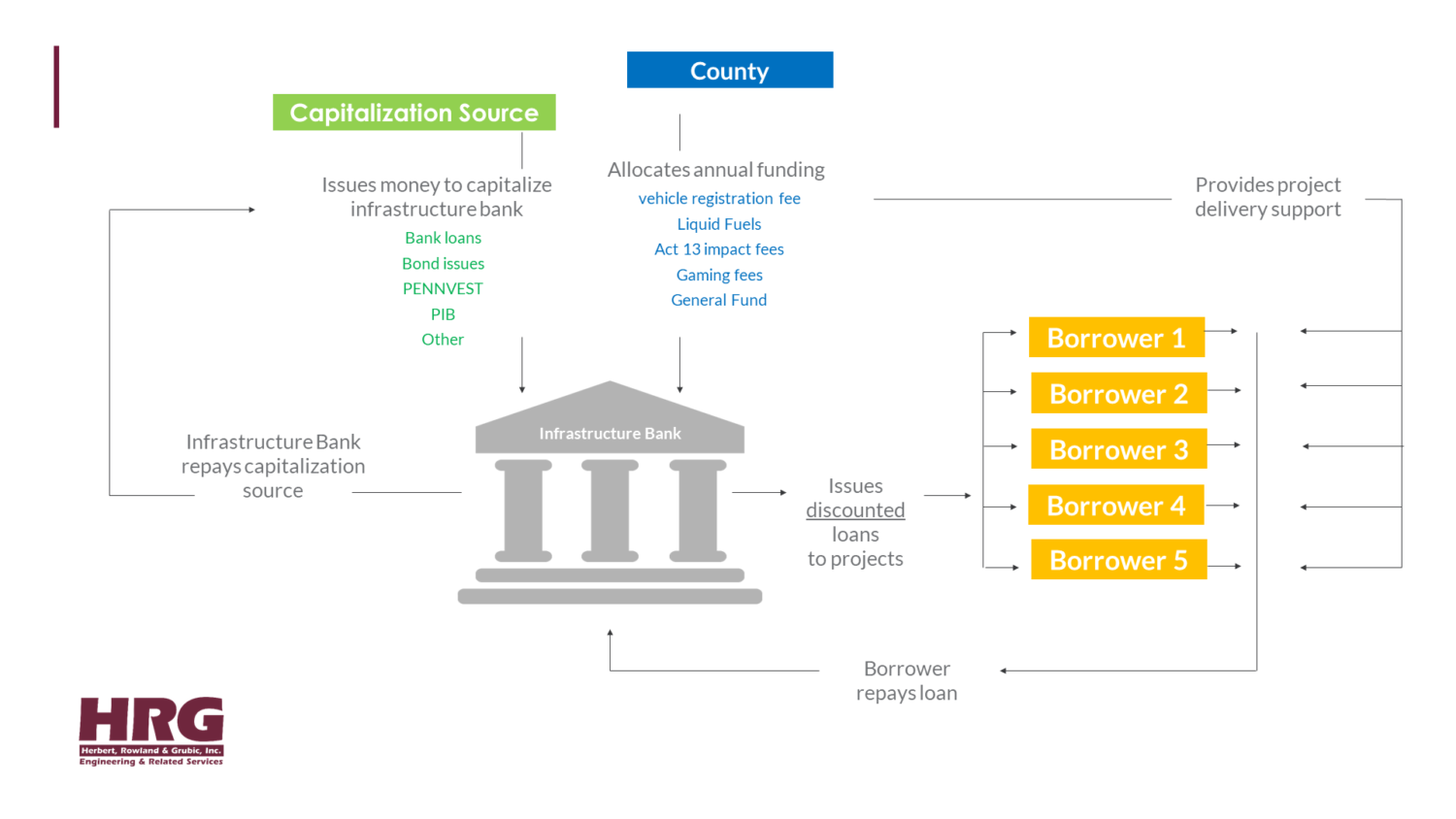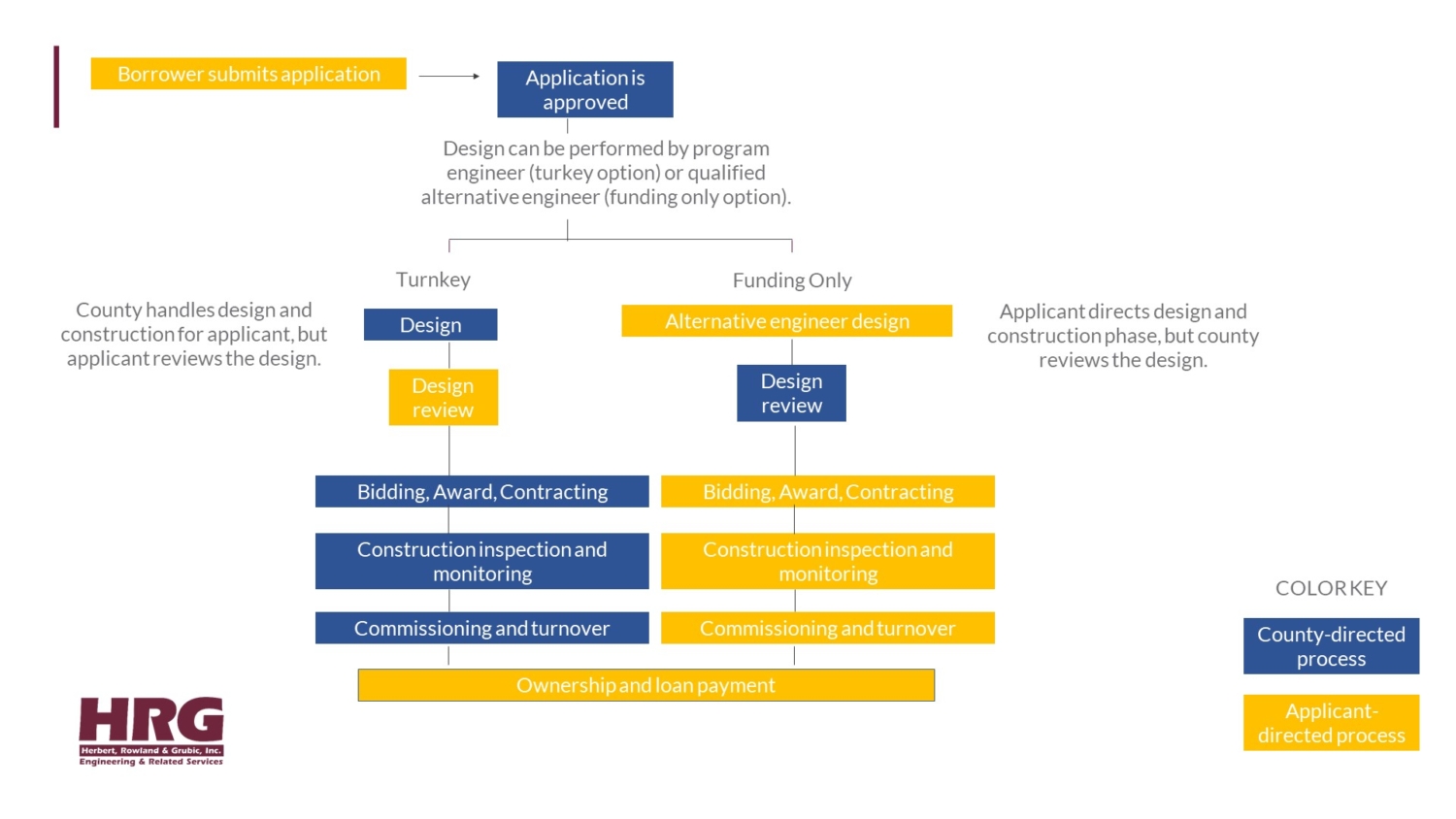Local governments are increasingly concerned about fixing their aging infrastructure, but they face two major obstacles: They don’t have the money or the experience to deliver complex construction projects.
Both of these problems can be solved with an innovative county infrastructure bank program that combines low-interest financing and project delivery support.
County and municipal leaders know it is wise to invest in their infrastructure. It promotes economic development because businesses want to build where they have access to transportation and utilities. It also protects the health and safety of a community, as those who’ve endured collapsed bridges or failing water systems and dams know all too well. What they don’t know is where to come up with the money to invest.
Pensions, social services, and health care costs consume large portions of the local government budget and continue to rise, while unfunded mandates from the federal government add increasing pressure on already tight budgets.
A county infrastructure bank program can help.
Using this approach, a county combines some of its money with an outside capitalization source to offer unbeatably low interest rates to municipalities and private entities for the construction of infrastructure improvements. As applicants repay their loans, the bank funds are replenished, and the cycle can begin again with new applicants, creating a self-renewing, permanent funding source.
Essentially, the county uses its money to subsidize loans for its municipalities, making infrastructure projects more affordable. But the county can also make the projects easier for municipalities to achieve by offering to manage project delivery, as well.
This is a key benefit of the program: many municipalities have little or no experience managing major infrastructure projects, and they can easily be overwhelmed by the complexities of the regulations and permit requirements that govern this work. This can lead to mistakes that delay the schedule or increase costs unnecessarily. Counties, on the other hand, have much more experience delivering large projects and can manage them efficiently, saving time and money.
Using a county infrastructure bank program, municipalities receive improved infrastructure for the lowest possible cost and minimal effort. But county officials benefit, too.
By improving the quality of life in individual municipalities, they attract growth to the county as a whole: businesses will create jobs, people will want to live there, and county officials will get the credit for making these improvements possible.
Benefits of an Infrastructure Bank Program
A county infrastructure bank is a sustainable, renewable source of funding
With a small up-front investment in program set-up and annual set-aside funding to subsidize the interest on its loans, counties are able to create a never-ending funding source that replenishes itself as municipalities and private organizations repay their loans.
The loans are more flexible and affordable for municipal recipients.
Because they subsidize the interest on the loans, counties are able to provide funding to selected municipalities at interest rates as low as 0.5% — lower than any other available loan program! In addition, counties adjust the amount of the award and its terms to meet the needs of the project and the loan recipient. For example, many grant programs will only cover costs associated with certain aspects of a project, but an infrastructure bank loan can cover the entire cost of the project, including administrative oversight, design fees, and construction.
By assuming responsibility for project delivery, the county makes complicated infrastructure improvements easy for municipalities.
Taking a project through design, bidding, and construction is a challenging task, made all the more complex by environmental and regulatory requirements. An inexperienced municipality or private entity may struggle to manage the complexities of such a project, which could lead to delays or additional cost.
By taking ownership of project delivery, the county ensures the project is completed efficiently — again, maximizing the value its dollar provides. (Counties that do not wish to shoulder the burden of project delivery alone can include the cost of an outside consultant in the program.)
It promotes economic development.
Many times, new developments cannot move forward because of the infrastructure needs they present: water or sewer extensions, traffic access or capacity issues, etc. The infrastructure bank ensures that money will be available to address those roadblocks in order to allow progress to occur.
The county is able to target its funding to long-term strategic goals by crafting these goals into the selection criteria for the loan. Applicants can be required to explain how their project will promote economic development, address safety deficiencies, or benefit under-served populations in rural or low-income areas.
It promotes regional solutions to problems.
Counties can promote projects that cross municipal boundaries (such as coordinating and re-timing the traffic signals along a heavily traveled corridor) and can promote multi-municipal coordination to increase the efficiency and effectiveness of a particular solution.

County infrastructure bank financing can be used to support commercial and industrial development that otherwise would’ve stalled due to infrastructure needs like utility lines or roadway improvements.
Counties can maximize the return on their budget dollars by using a small reserve to subsidize a much larger pool of money, funding multiple projects instead of just one.
As local government budgets continue to shrink while obligations rise, this ability to stretch the impact of every dollar will be crucial to the success of every community.
How an Infrastructure Bank Program Works
Step 1 – Obtaining the Funds
Perhaps the best way to understand how a county infrastructure bank works is to look at a county who is using the program with great success.
Dauphin County, Pennsylvania, has $325,000 per year in Liquid Fuels funding to invest in infrastructure improvements. In today’s market, this wouldn’t even be enough to cover the cost of a single-span bridge replacement (which can typically run between $500,000 to $1 million).
The county was thus faced with a choice: It could put this money toward one project (although additional funds would be needed to actually complete the project), or it could parcel it out into small sums to each of its municipalities. Unfortunately, county officials realized, neither approach would provide much impact. It would make the county like a hamster on a wheel: never running fast enough to get anywhere in terms of true infrastructure improvement.
Unhappy with either choice, officials created a third option: The county places the $325,000 into its own infrastructure “bank” and makes an arrangement to borrow additional money from the state department of transportation through its Pennsylvania Infrastructure Bank program (PIB). The exact amount of money the county borrows will depend on what it can subsidize with its $325,000 allocation and what the projects it selects require. (This is a flexible funding program. Rather than set a generic award amount, the county can base the loan on the exact amount of money the applicant needs to complete the project.)
With an agreement in place, the county seeks project applicants and selects those that are the most feasible and beneficial to the community. As the projects are completed, the applicants repay the loan, and the county uses those funds to repay the Pennsylvania Infrastructure Bank (PIB). As it’s repaid, PIB continues to pour the money back into Dauphin County’s Infrastructure Bank, so that the cycle can continue with new loans for new projects.
This process is illustrated below.

In this example, the county is providing five separate loans, but it is not limited to five. It can provide any number of loans, depending on the amount of available funds and the project needs. Five is used here simply for illustrative purposes.
Instead of partially funding one small project, the county is able to fund multiple projects, greatly magnifying the impact of that $325,000. What’s more, they can repeat the entire process with new projects every year.
In its first five years, the Dauphin County infrastructure Bank funded 15 projects worth more than $25 million. These projects included bridges, traffic signals, stormwater management, streetscape beautification, and intersection redesign.
Depending on the source of the funds, a county infrastructure bank can be used for any type of infrastructure improvement: roadways, bridges, stormwater, sanitary systems, etc. Different funding programs have their own requirements about how the money can be used.
Dauphin County, for example, uses its Liquid Fuels funding for its annual allocation and capitalizes its account with a loan from PennDOT’s Pennsylvania Infrastructure Bank. Since these funding sources must be used for transportation improvements, the Dauphin County Infrastructure Bank only funds roadways, bridges, and traffic projects. However, the county infrastructure bank approach could also be used for water and sewer systems or stormwater management, etc.
In order to create and maintain an infrastructure bank program, a county must have enough money available annually to fund its interest obligation. To have a significant impact with the program, the county should ideally have at least $250,000 in annual allocations available.
These allocations can come from a wide variety of sources:
- Liquid Fuels funds
- Act 13 Impact Fees
- Gaming Funds
- Act 89 County Vehicle Registration Fees
Each funding source will have its own requirements for how the money can be used, and this will influence what types of projects the infrastructure bank can fund. The same is true of the outside loan programs from which the county will borrow to capitalize its infrastructure bank.
Potential capitalization sources include:
- Bank loans
- Bond issues
- PENNVEST
- USDA
- Commonwealth Financing Authority
Some extra money is required in the beginning for administrative costs associated with setting up the program, but future program delivery costs are worked into the loans the county provides.
A firm with dual expertise in infrastructure and public financing can help county officials find the money they need for the annual allocation by setting appropriate goals. For example, Dauphin County was able to free up the funds after completing an ambitious capital improvement program for its bridges. With all of its bridges repaired or replaced, the county was able to take $300,000 in Liquid Fuels money it previously invested annually in its bridges and invest instead in the infrastructure bank.
Step 2 – Selecting Projects to Support
Before initiating its first loan, a county should design a formal application and competitive selection process to issue the infrastructure bank loans. The process should be designed to prioritize the most critical needs within the local community.
Selection criteria can consider:
- the impact of a project on economic growth.
- whether safety improvements are achieved.
- whether traffic accidents will be reduced.
- how many municipalities will benefit from the project (encouraging a regional planning approach through multi-municipal coordination).
- the size and resources of the municipal project sponsor. (Smaller municipalities are given higher priority since they need a program like this more than larger metropolitan areas that likely have more resources.)
The county will use this selection criteria to ensure its strategic planning goals are met with the funds it disburses, that each project moves the county forward in terms of promoting safety, economic development, and quality of life.
Because they have taken a proactive approach and identified up front where they want the county to go, they can make sure each dollar they invest gets them one step closer to that goal. (This is opposed to the reactive approach many local governments are forced to take with maintenance due to budget pressures. By only investing in repairs when something is failing, one can only hope to maintain the status quo but can never hope to move forward.)
A county infrastructure bank program is a wise use of public funds that maximizes their reach, but it is also a safe investment: Counties can ensure the loans they make are paid back by requiring a credit check and some sort of collateral. (For instance, Dauphin County requires municipal recipients to pledge their Liquid Fuels allocation. Private entities must provide a letter of credit.) In addition, the county further protects its investment by managing the bidding and construction process.
Infrastructure banks can issue loans to a wide variety of recipients:
- Municipalities or municipal authorities
- School districts
- Non-profits
- Developers
- Private businesses
In fact, the county itself can apply for funds in the case of an emergency or unforeseen circumstance.
When an organization shows interest in applying for a loan, the county meets with them to ensure that their project is a good fit for the program, that the applicant understands how much the project will cost and is prepared to repay the loan, and that the project is a good investment of county resources.
If the project is selected for funding, the applicant moves on to the project delivery phase.
Step 3 – Managing Project Delivery
Both the county and the municipality are investing money in the success of the project: Though the municipality will ultimately pay for the project by repaying the loan, the county must guarantee that loan up front and subsidize its interest. Therefore, the program is set up to protect both of their financial interests.
Large infrastructure improvement projects are complex, and they can easily encounter cost overruns when mistakes cause re-work or delays. Inexperienced municipalities or private entities can rely on the county’s design team to provide engineering services for the project in order to ensure it is delivered in the most efficient manner possible. The cost of this service is included in the loan.
Historically, most program applicants are happy to take advantage of this option, but those that wish to use their own engineer to design the project are free to do so. If an applicant does use its own engineer, the county’s design team reviews the design to ensure it conforms to the program specifications and delivery program guidelines.
Once the design is complete, the county bids the project and manages the construction contract. After the project is built, it is turned over to the applicant, who assumes all future responsibility for it, and pays back the loan. With the money repaid, the county has funds to start the process over again with a new applicant.

Getting Started with an Infrastructure Bank Program
Counties interested in creating an infrastructure bank should work with a consultant that possesses dual expertise in civil engineering and financial consulting. This consultant can help them find the necessary funding in their own budget and identify outside sources for capitalizing the bank. It can also help the county plan for its long-term infrastructure goals and design an application process that ensures those goals are met by the selected projects. In addition, the right consultant can design a loan administration process that gently guides borrowers through the complex regulatory environment.
The typical steps for establishing a county infrastructure bank program are as follows:
- Identify unmet infrastructure needs and high-level planning
- Identify a county funding source and the amount to invest into the program.
- Identify capitalization funding sources compatible with county funding and project types.
- Prepare financial models to determine program parameters (i.e., loan terms, rates, fees, etc.)
- Develop an educational outreach program for local municipalities to gauge their interest in program
participation.
(Portions of this article were printed in the February 2021 issue of Pennsylvania Borough News magazine.)
Do you want to learn more?
Hear all about how infrastructure banks work from the men behind the first two county infrastructure banks in Pennsylvania: Brian Emberg and Jeff Mikesic. Watch their webinar below:
HRG Can Help
HRG’s Financial Services Team created the first county infrastructure bank in Pennsylvania. Their work has received national recognition and has helped many communities throughout the state address aging infrastructure and promote economic development. Contact us for a free consultation to discuss the possibilities for your community.
In this one-hour session, we will evaluate:
- the funding you have available,
- the restrictions on those funds,
- the types of projects you’d like to complete, and
- the potential sources you can access to capitalize the bank.

